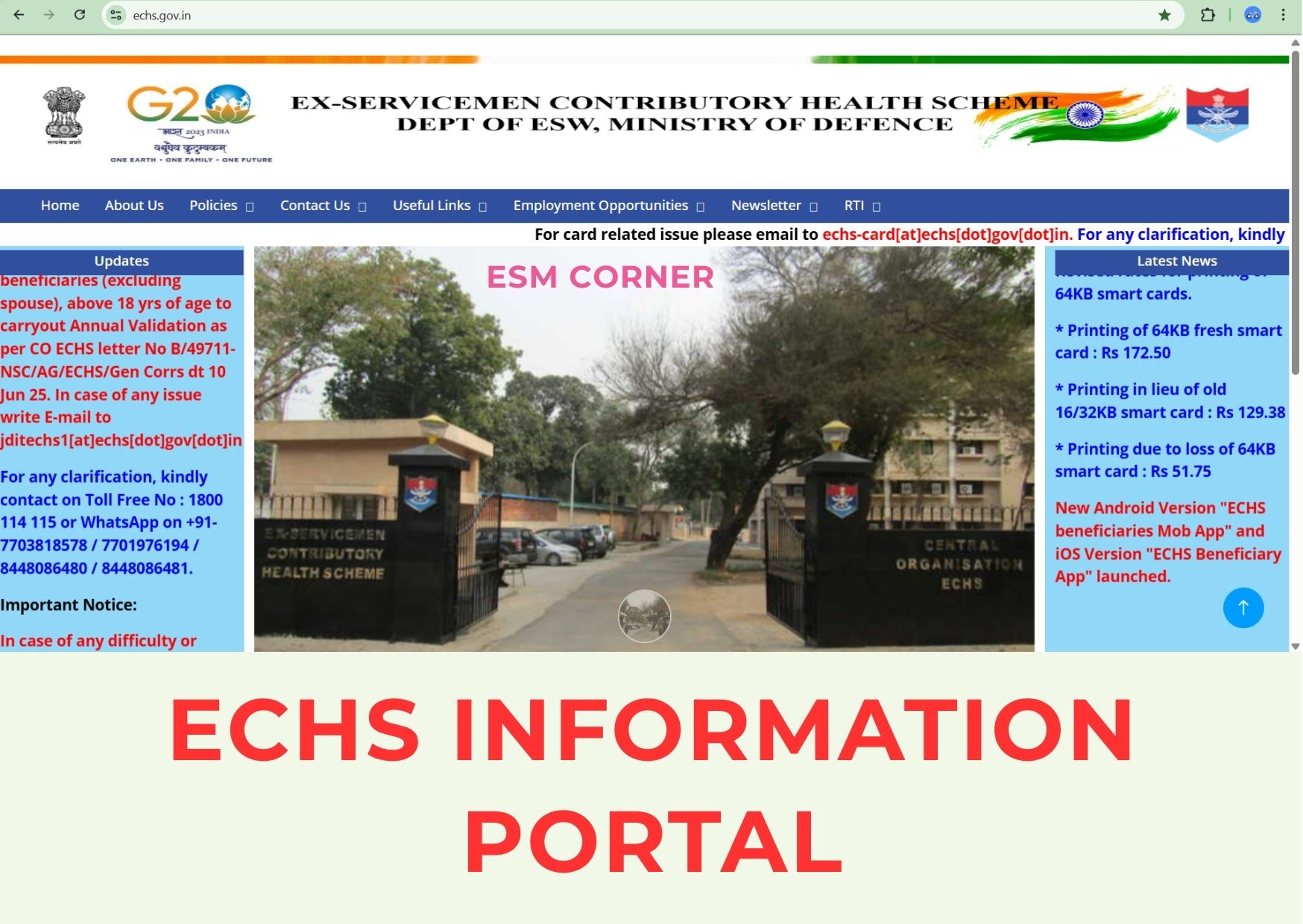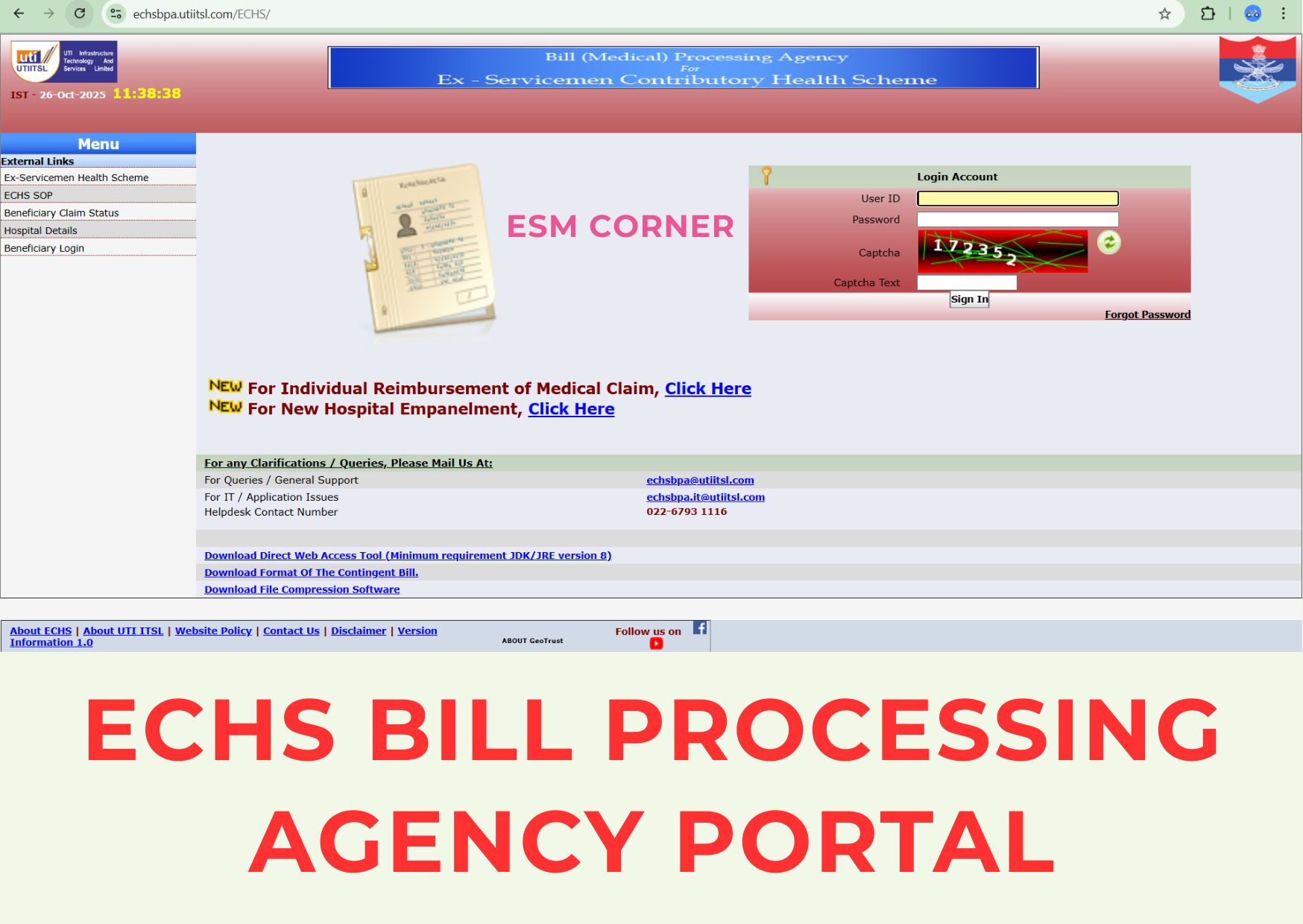
The Ex-Servicemen Contributory Health Scheme (ECHS) is a critical welfare scheme under India’s Ministry of Defence, providing subsidised health care services to ex-servicemen, pensioners, and their dependents by empaneling hospitals and managing claims, treatment, and administrative processes. To support this, ECHS utilises various web portals to interface with beneficiaries, hospitals, and administrators. The three key portals are:
- ECHS official website (www.echs.gov.in) — the primary information portal and gateway to services, circulars, policies, announcements and useful links.
- ECHS BPA Portal (echsbpa.utiitsl.com/ECHS) — for beneficiary claims, hospital empanelment, claim submission, check status, etc.
- ECHS Smart Card Application Portal (echs.sourceinfosys.com) — to apply for or manage the 64 KB smart card that authorises treatment and access to empanelled hospitals.
Together, these portals form the digital backbone of ECHS’s interface with its stakeholders. Below we dissect each one in depth, compare their roles, and suggest how users can navigate them most effectively.
1. ECHS Official Website (www.echs.gov.in)
The ECHS official site is the central information hub. It sets out policies, Standard Operating Procedures (SOPs), organizational structure, contact details, circulars, regional centres, and useful links to the transactional portals (BPA, smart card, etc.). For many beneficiaries, it is the first entry point.
Key Features
- Home / Announcements / Latest Updates: The site frequently publishes updates such as resumption of 64 KB card printing, new circulars, policy changes, etc.
- Policies / SOPs / Operations & Coordination: Sections describing how ECHS functions at national, regional and station levels, and how medical security, vigilance, finances, etc., are managed.
- Contact Us / Regional Centres / Record Office: Addresses and contact numbers of Central Organisation and Regional Centres.
- Useful Links: Critical because the official site itself is not the portal for claims or card applications. It links to BPA portal, smart card portal, record office, regional centre portals, etc.
- Newsletter / Publications: ECHS publishes newsletters and public bulletins to keep beneficiaries aware of policy changes or service updates.
- Help / Notices / Important Alerts: Notices about printing, card validity, application procedures, etc. For example, the site states that printing of 64 KB ECHS cards was resumed from January 2025 and gives updated pricing.
Strengths
- Acts as the authoritative reference – users can trust official circulars posted here.
- Good organization of links to all associated portals, reducing confusion on navigation.
- Contact information is clearly visible (toll-free number, WhatsApp, emails).
- It provides notices to address service problems (e.g. shortcomings at empanelled hospitals) and encourages beneficiaries to escalate issues to regional centres.
- It consolidates the policies, SOPs, and circulars in one place, useful for research, grievances, or reference.
Challenges / Observations
- It is largely informational; users cannot perform claims or application tasks directly here—this is by design, but may confuse less tech-savvy users who might expect forms.
- The sheer number of portals linked may overwhelm new users.
- The interface could be more user-friendly for older beneficiaries (font sizes, navigation clarity, mobile optimization).
- Search and filtering in circulars or notices might need improvement.
How Users Should Use It
- Always start here to see latest updates, new circulars, or policy changes.
- Use “Useful Links” section to jump into BPA or smart card portal.
- For grievances in hospitals, follow the contact or regional centre escalation paths listed.
- Download relevant circulars or SOPs for claim disputes, appeals or to understand entitlement.

2. ECHS BPA Portal
The BPA (Business Process Automation) Portal is the transactional backbone for ECHS — where beneficiaries, hospitals, and administrators do operational tasks: submitting claims, checking claim status, hospital empanelment, beneficiary management, etc. It is in effect the “workhorse” system behind many ECHS processes.
Key Functions (as inferred from ECHS “Useful Links”)
Because the BPA site itself was showing an internal error when tried to fetch, the official ECHS main site still references several functionalities that BPA is responsible for, such as:
- Beneficiary Claim Submission :Only registered beneficiaries with valid 64 KB smart cards can submit claims online. Unregistered or inactive cards may require offline submission.
- Claim Status Checking
- Empanelled Hospital Details
- Beneficiary Management
- Miscellaneous BPA services for hospitals & regional centres
Thus, BPA is the portal through which medical claims by beneficiaries are processed, tracked, and settled, and through which hospitals engage with ECHS administration.
Strengths
- Centralizes claim processing, reduces administrative friction
- Supports transparency: beneficiaries can check their claim status
- Integrates hospital data and empanelment details so beneficiaries know which hospitals are in-network
- Allows scaling across regions because BPA can handle data flow between central, regional, and hospital units
Challenges / Observations
- The internal error at time of access suggests server or stability issues, which hurt stakeholder trust.
- If performance, uptime or logging is not robust, it may hamper claims or delays.
- The user interface and usability (for both beneficiaries and hospital staff) are critical — if not intuitive, many will struggle.
- Support and help sections, error messaging, FAQs are essential but not clearly visible in the portal’s description.
How Users Should Use It
- Log in with correct beneficiary credentials to submit claims for reimbursement or procedure payments.
- Use “Claim Status” module to track progress and avoid repeated inquiries.
- Hospitals can use empanelment modules or patient validation modules via BPA.
- Use the portal as the primary interface between beneficiary and ECHS administration for medical claims rather than offline paperwork (when possible).

3. ECHS Smart Card Application Portal
This portal specializes in the application, management, and issuance of the 64 KB ECHS smart card — a mandatory card for beneficiaries to access health services under ECHS. It is designed for beneficiary access and Card Service Centres (CSCs) to manage applications.
Key Features
- Smart Card Application / Online Application: Beneficiaries can apply for a new smart card or replacement through this portal.
- CSC Login / CSC Functions: Card Service Centres use login credentials to process or verify applications. Some regional CSCs still require physical verification; the online portal alone may not complete the process.
- FAQ & Downloads: The portal hosts downloads and helpful instructions for applicants.
- Cookie / Privacy Policy: Standard web policies about cookies and user consent appear.
- Error / Load Handling: The portal shows a loading status and handles cookies acceptance.
Strengths
- Specialized focus ensures streamlined application for smart cards.
- Enables remote submission of smart card requests rather than requiring in-person only.
- Helps standardize smart card issuance across regions.
- Provides transparency into the application process via CSC login or status updates.
Challenges / Observations
- The portal UI is relatively minimal; more detailed progress tracking or user dashboards would improve experience.
- Need for robust security and validation checks, because smart cards authorize critical health access.
- Support for mobile UI, user help, multilingual instructions are essential for broad adoption.
- If CSC login or verification is delayed or the backend is slow, applicants will wait.
How Users Should Use It
- Beneficiaries should register via this portal to apply for their smart card (fresh or replacement).
- Use the FAQ / help section for guidance on required documents, photo norms etc.
- Track application status; follow up where delays occur via contact information.
- If you are stationed at or near a Card Service Centre (CSC), use your login for processing tasks or validation.
Comparative Analysis & Integration
Roles & Boundaries
- ECHS official website: the public face, reference and guide.
- BPA portal: the transactional engine for claims, beneficiary management and hospital dealings.
- Smart Card portal: a specialist transactional portal for issuance and management of smart cards.
These three must interoperate seamlessly: the official site must link to the others, BPA must verify smart card status, and the smart card portal must feed beneficiary data into BPA. Disruptions in any part affect the overall user experience.
Synergy & Workflow
- A beneficiary visits the ECHS official site to learn about policies, eligibility and notice updates.
- The site directs the person to the smart-card portal to get or renew their card.
- Once the card is active, the beneficiary uses the BPA portal to submit medical claims, check hospital empanelment and status.
- Hospitals interface via BPA to process claims and cross-check beneficiary card validity.
- The official site also hosts circulars and policy changes affecting these portals, creating a feedback loop.
Success Factors
- Reliability & Uptime: All portals must remain accessible, especially BPA and smart card portal.
- User Interface / Usability: Simple navigation, clear instructions, multilingual support and optimized layouts for mobile & desktop.
- Support & Helpdesk: Clear help sections, FAQs, contact numbers, escalation paths.
- Security & Data Integrity: Because these handle sensitive personal and medical data, robust encryption, authentication and validation are essential.
- Scalability & Regional Reach: Able to serve remote areas, offline fallback where Internet is weak, CSC backups.
- Integration: Data sync among portals must be efficient (card status, claim eligibility, hospital updates).
Suggestions / Best Practices for Beneficiaries
- Start with ECHS official site — Always check for the latest circulars or notices before applying for card or claims.
- Smart Card first — Without the 64 KB smart card, many claims won’t be accepted in empanelled hospitals.
- Use BPA for claims — Prefer online submissions over physical ones for transparency & tracking.
- Keep document copies — Passport photos, identity proofs, PPO (Pension Payment Order), etc.
- Follow up via contact channels — Use regional centre addresses from the official site for grievance escalation.
- Monitor timelines — Note processing times, check status periodically, raise complaints in case of delays.
- Stay updated — Use the official site or newsletters for upcoming policy changes (eligibility, hospital lists, claim caps).
Conclusion
The three portals — ECHS official website, BPA Portal, and Smart Card Application Portal — together enable ex-servicemen to navigate policy, apply for cards, and submit medical claims under ECHS. Their combined success depends on usability, reliability, integration, and support. For beneficiaries, mastery of this digital architecture is vital to claim rightful healthcare benefits efficiently.
ALSO READ : COMMON SPARSH-RELATED PROBLEMS AND THEIR COMPREHENSIVE SOLUTIONS






Can a SSC AMC Offr released in1991 on completion of tenure apply for ECHS without payment?
Yes, all sscos are authorised ECHS facilities under non pensioner catagory. Pensioners retired before 01 Jan 96 are exempt from pay contribution.